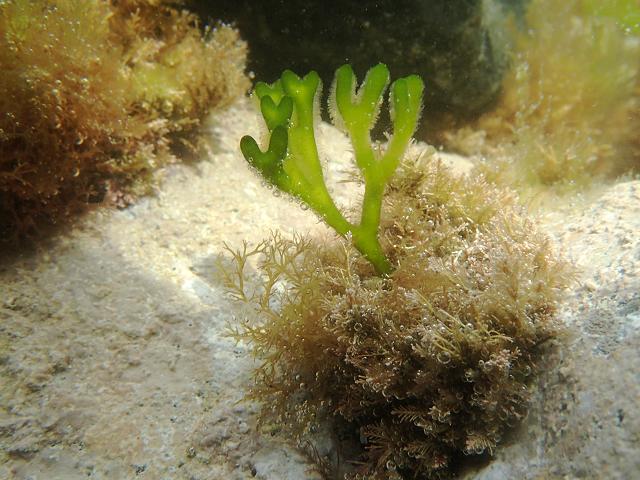
APHOTOMARINE
An educational resource dedicated mainly to the photography
and diversity of marine life that can be found in coastal waters
and intertidal areas of Great Britain and Ireland by David Fenwick.

Codium fragile subsp. fragile (Suringar) Hariot, 1889 - Green Sea Fingers - non-native species (Green seaweeds)
Scroll down and rollover titles to change screen image or click on title to view image.
Green Sea Fingers
Codium fragile subsp. fragile
- underwater in rockpool 1
Codium fragile subsp. fragile
- underwater in rockpool 1
Green Sea Fingers
Codium fragile subsp. fragile
- underwater in rockpool 2
Green Sea Fingers
Codium fragile subsp. fragile
- underwater in rockpool 3
Green Sea Fingers
Codium fragile subsp. fragile
- underwater in rockpool 4
Green Sea Fingers
Codium fragile subsp. fragile
- close-up of branch tip 1
Green Sea Fingers
Codium fragile subsp. fragile
- pointed utricles 1
A non-native species, specimens above found in pools on the upper-middleshore at Skilly, south of Newlyn, Cornwall, 16.08.18.
Green Sea Fingers
Codium fragile subsp. fragile
- underwater 1
Green Sea Fingers
Codium fragile subsp. fragile
- frond tip underwater 1
Green Sea Fingers
Codium fragile subsp. fragile
- frond tip underwater 2
Green Sea Fingers
Codium fragile subsp. fragile
- frond tip close-up 1
Green Sea Fingers
Codium fragile subsp. fragile
- pointed utricles 2
Green Sea Fingers
Codium fragile subsp. fragile
- pointed utricles with rule 1
A non-native species, specimen found in an uppershore pool at Battery Rocks, Penzance, Cornwall. 26.10.14.
Codium fragile subsp. fragile (Suringar) Hariot, 1889 is synonymous with Codium fragile ssp. tomenosoides.
Scientific and European Names:
Codium fragile subsp. fragile, Codium fragile subsp. tomenosoides, Green Sea Fingers, Dead Man's Finger, Green Fleece, Sputnik weed.
AlgaeBase is a database of information on algae that includes terrestrial, marine and freshwater organisms.

The main objective of this website is in furthering environmental awareness and education through the medium of photography. To increase awareness and access to the wildlife of the region and help
people find and identify it. Sometimes the difference between species is obvious but many species can only be determined by observing microscopic characteristics that are specific to any one species.